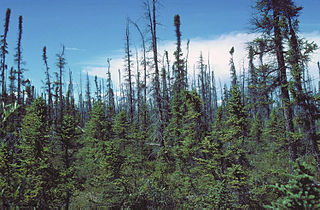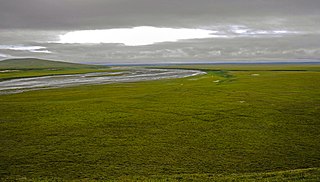
James Bay is a large body of water located on the southern end of Hudson Bay in Canada. Both bodies of water extend from the Arctic Ocean, of which James Bay is the southernmost part. Despite bordering the Canadian provinces of Quebec and Ontario, the bay and the islands within it, the largest of which is Akimiski Island, are politically part of Nunavut.

Baffin Island, in the Canadian territory of Nunavut, is the largest island in Canada and the fifth-largest island in the world. Its area is 507,451 km2 (195,928 sq mi)—slightly larger than Spain, its population was 13,039 as of the 2021 Canadian census, and is located at 68°N70°W. It also contains the city of Iqaluit, the capital of Nunavut.

Ukkusiksalik National Park is a national park in Nunavut, Canada. It covers 20,885 km2 (8,064 sq mi) of tundra and coastal mudflats south of the Arctic Circle and the hamlet of Naujaat, from Hudson Bay's Roes Welcome Sound towards the western Barrenlands and the source of Brown River. The park surrounds Wager Bay, a 100 km (62 mi)-long inlet on the Hudson Bay. Although the smallest of Nunavut's four national parks, it is the sixth largest in Canada. Its name relates to steatite found there: Ukkusiksalik means "where there is material for the stone pot".

The ivory gull is a small gull, the only species in the genus Pagophila. It breeds in the high Arctic and has a circumpolar distribution through Greenland, northernmost North America, and Eurasia.

Akimiski Island is the largest island in James Bay, Canada, which is part of the Qikiqtaaluk Region of the territory of Nunavut. It has an area of 3,001 km2 (1,159 sq mi), making it the 163rd largest island in the world, and Canada's 29th largest island. Akimiski Island is 19 km (12 mi) from the province of Ontario. From the western side of the island, the Ontario coastline is visible.

Foxe Basin is a shallow oceanic basin north of Hudson Bay, in Nunavut, Canada, located between Baffin Island and the Melville Peninsula. For most of the year, it is blocked by sea ice and drift ice made up of multiple ice floes.

Wapusk National Park (; is Canada's 37th national park, established in 1996. The name comes from the Cree word for polar bear.

Sirmilik National Park is a national park located in Qikiqtaaluk, Nunavut, Canada, established in 1999. Situated within the Arctic Cordillera, the park is composed of three areas: most of Bylot Island with the exception for a few areas that are Inuit-owned lands, Oliver Sound, and Baffin Island's Borden Peninsula. Much of the park is bordered by water.

Chionophiles are any organisms that can thrive in cold winter conditions. These animals have specialized adaptations that help them survive the harshest winters.

The Hudson Plains Ecozone, as defined by the Commission for Environmental Cooperation (CEC), is a sparsely populated Canadian subarctic ecozone extending from the western coast of Quebec to the coast of Manitoba, encompassing all coastal areas of James Bay and those of southern Hudson Bay, stretching to about 50°N latitude. It includes the largest continuous wetland in the world. It covers nearly a quarter of Ontario's landmass, and 3.6% of Canada's total area, totalling approximately 369,000 square kilometres of land and 11,800 square kilometres of water. Its historical prominence is due to the harshness endured by pioneer explorers who established fortifications for Hudson's Bay Company, and as a result of regional wars between France and Britain. Today, it is primarily noted for the well-known Polar Bear Provincial Park, and to a lesser extent Wapusk National Park, as well as its vast wetlands which are used by migratory birds.
The Twin Islands are similarly shaped Arctic islands in the Qikiqtaaluk Region of Nunavut, Canada. They are located in central James Bay, 56 km (35 mi) north east of Akimiski Island, and 58 km (36 mi) west of Quebec. The group includes North Twin and South Twin islands.
Bluenose Lake is a lake in Kitikmeot Region, Nunavut, Canada. It is located north of the Arctic Circle within the large, shallow basin of the Melville Hills. It is approximately 33 mi (53 km) long, 12 mi (19 km) wide, and is situated at 1,800 ft (550 m) above sea level. The Croker River flows north from Bluenose Lake to the Arctic Ocean, entering at Dolphin and Union Strait.
Sunday Island is one of several uninhabited Canadian arctic islands in Nunavut, Canada located within James Bay. Nearby are the Bear Islands.
Spencer Island is one of several uninhabited Canadian arctic islands in Nunavut, Canada located within James Bay. It is situated 19 km (19,000 m) northwest from North Twin Island. During surveys in James Bay, polar bears were sighted using the island for summer refuge.
Walter Island is one of several uninhabited Canadian arctic islands in Nunavut, Canada located within James Bay. It is 3 km2 (1.2 sq mi) in size, and is situated 15 km (9.3 mi) east of North Twin Island.
The Boas is a river on Southampton Island in Nunavut, Canada. The river rises at 64°49′58″N084°23′34″W and its mouth is located at the Bay of Gods Mercy. Proceeding inland, the river becomes braided and is about 5 kilometres (3.1 mi) wide.
The East Bay Migratory Bird Sanctuary is a migratory bird sanctuary in Kivalliq, Nunavut, Canada. It is located in East Bay, an arm of Hudson Bay, in southeast Southampton Island. The nearest community is Coral Harbour, 44 mi (71 km) to the west. It is one of two bird sanctuaries on the island, the other being the Harry Gibbons Migratory Bird Sanctuary, situated 87 mi (140 km) to the southwest.
Seymour Island is an uninhabited island in the Qikiqtaaluk Region of northern Canada's territory of Nunavut. A member of the Berkeley Islands group, it is located approximately 30 mi (48 km) north of northern Bathurst Island. Between Seymour Island and Bathurst Island lies Helena Island. Penny Strait lies about 90 km (56 mi) to the east where open water polynyas occur.
The Kendall Island Migratory Bird Sanctuary (KIBS) is a migratory bird sanctuary in the Northwest Territories, Canada. It is located on Kendall Island and its surrounding area in Mackenzie Bay at the northern tip of the Mackenzie River Delta. A seasonal sanctuary for more than 60,000 shorebirds. it is one of five bird sanctuaries within the Inuvialuit Settlement Region. The area that is now known as the KIBS is a traditional Inuvialuit whaling site.

The Arctic coastal tundra is an ecoregion of the far north of North America, an important breeding ground for a great deal of wildlife.












